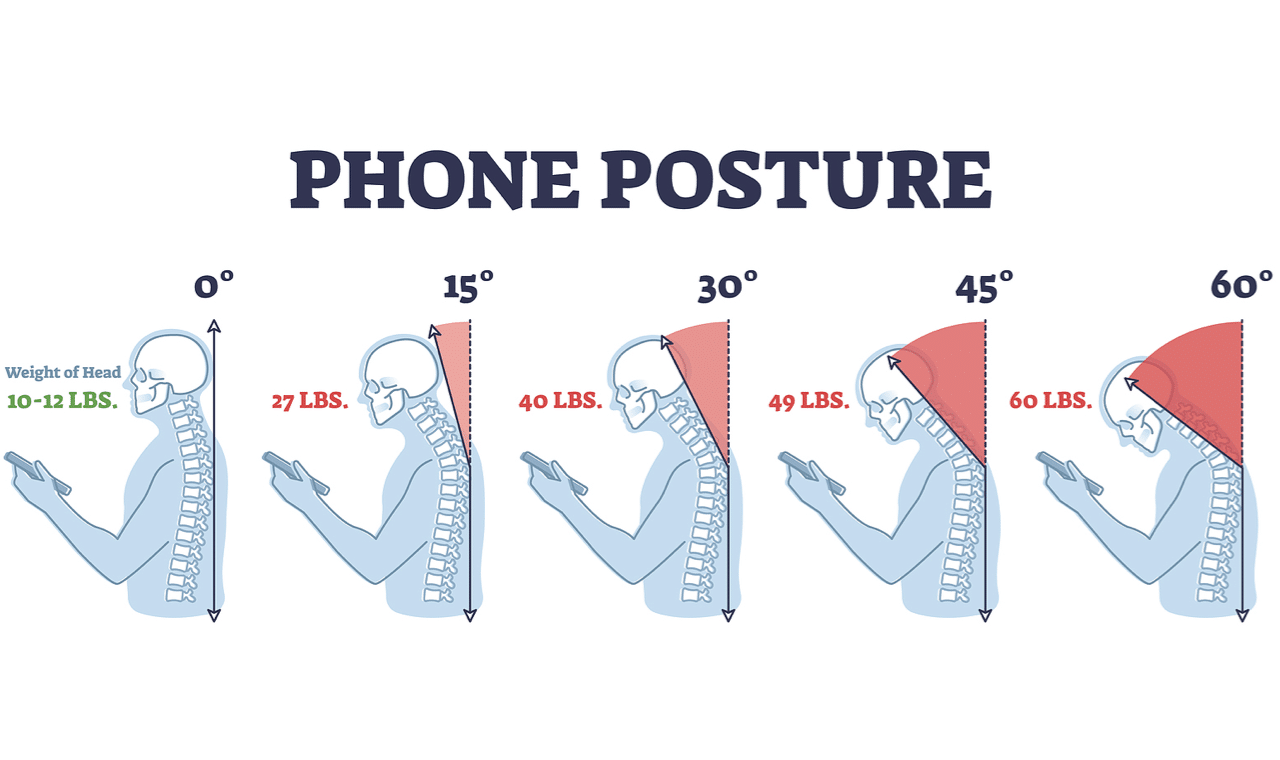The Silent Epidemic: Understanding and Combating smartphone Neck
In the digital age, smartphones have become indispensable tools, connecting us to information, entertainment, and each other. However, this constant connectivity comes at a cost, manifesting in a growing health concern: “smartphone neck,” also known as “text neck.” This condition, characterized by neck pain, stiffness, and headaches, is rapidly becoming a widespread issue, affecting individuals of all ages. This article delves into the causes, symptoms, consequences, and solutions for smartphone neck, providing a comprehensive understanding of this modern ailment.
The human head, weighing approximately 10-12 pounds, is balanced on the cervical spine. When we maintain proper posture, the weight is evenly distributed. However, when we tilt our heads forward to look at our smartphones, the effective weight on the spine increases dramatically. For every inch the head tilts forward, the force on the neck doubles. At a 60-degree angle, the weight on the neck can reach a staggering 60 pounds.

This excessive strain is primarily due to the repetitive and prolonged forward flexion of the neck, leading to:
Muscle Imbalance
The muscles at the back of the neck and upper back become overstretched and weakened.
Disc Compression
The intervertebral discs, which act as shock absorbers between the vertebrae, are subjected to increased pressure.
Joint Dysfunction
The facet joints in the cervical spine, responsible for movement and stability, become misaligned and inflamed.

Smartphone neck manifests in a variety of symptoms, which can range from mild discomfort to debilitating pain. Common symptoms include:
Neck Pain and Stiffness
Aching or sharp pain in the neck, often radiating to the shoulders and upper back.
Headaches
Tension headaches, often felt at the base of the skull or behind the eyes.
Upper Back and Shoulder Pain
Pain and stiffness in the upper back and shoulders, often described as a burning or aching sensation.
Numbness and Tingling
Numbness, tingling, or weakness in the arms and hands, caused by nerve compression.
Other Symptoms
Jaw pain and temporomandibular joint (TMJ) disorders.
If left untreated, smartphone neck can lead to serious long-term consequences, affecting overall health and well-being. These include:
Chronic Pain
Persistent neck pain, headaches, and upper back pain, significantly impacting quality of life.
Spinal Degeneration
Accelerated wear and tear of the cervical spine, leading to arthritis and disc degeneration.
Postural Deformities
Forward head posture, rounded shoulders, and kyphosis (exaggerated curvature of the upper back).
Reduced Lung Capacity
Mental Health Issues
Fortunately, smartphone neck is largely preventable and treatable. By adopting healthy habits and seeking appropriate care, individuals can mitigate the risks and alleviate the symptoms.
Maintain Proper Posture
Hold your smartphone at eye level to minimize neck flexion.
Ergonomic Adjustments
Use a smartphone holder or stand to elevate your device.
Regular Exercise and Stretching
Perform neck stretches and exercises to strengthen the neck and upper back muscles.
Limit Screen Time
Set time limits for smartphone usage, especially before bedtime.
Physical Therapy
A physical therapist can assess your posture, muscle strength, and range of motion.
Chiropractic Care
A chiropractor can perform spinal adjustments to correct misalignments and restore proper joint function.
Massage Therapy
Massage therapy can relieve muscle tension and pain in the neck, shoulders, and upper back.
Pain Management
Over-the-counter pain relievers, such as ibuprofen or acetaminophen, can provide temporary relief.
Acupuncture
Acupuncture can stimulate specific points on the body to relieve pain and promote healing.
Raising awareness about the risks of smartphone neck is crucial in combating this growing health concern. Educational campaigns and public health initiatives can help individuals understand the importance of proper posture, ergonomic adjustments, and regular exercise.
Parents and educators play a vital role in teaching children and adolescents about the dangers of excessive screen time and the importance of healthy habits. By promoting responsible smartphone usage from an early age, we can help prevent the development of smartphone neck and its long-term consequences.
Smartphone neck is a modern ailment that poses a significant threat to our physical health and well-being. By understanding the causes, symptoms, and consequences of this condition, we can take proactive steps to prevent and treat it. Maintaining proper posture, making ergonomic adjustments, engaging in regular exercise, and seeking appropriate care are essential for mitigating the risks and alleviating the symptoms.
In a world increasingly reliant on technology, it is imperative that we prioritize our health and well-being. By adopting healthy habits and promoting responsible smartphone usage, we can ensure that our digital connectivity does not come at the expense of our physical health. It is about balance, and being mindful of the physical effects of our digital habits.



